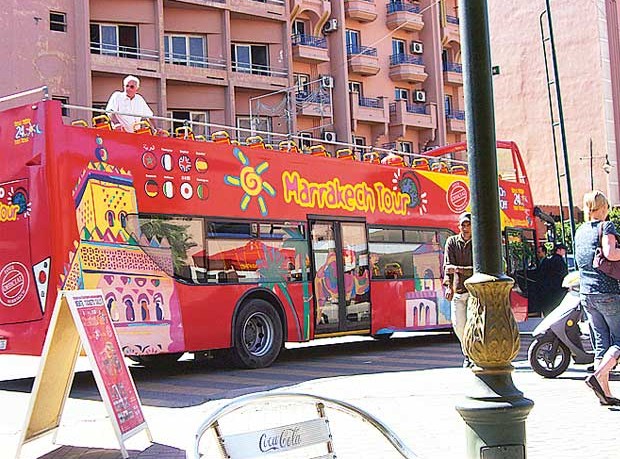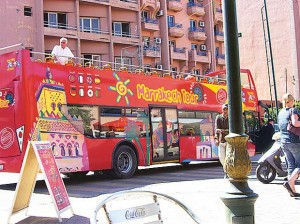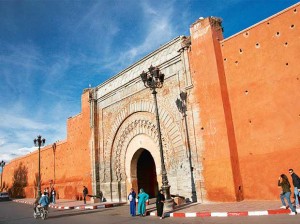Business Standard
Kishore Singh
Marrakech is a place many of us only imagine because, surely, it doesn’t exist outside fable. Or does it? A week in Morocco furnishes us indelible proof of its existence, but how does it compete with imagination? I can recall Jardin Majorelle’s cactus garden with its Moorish structure of such vivid blue, it makes my heart ache as much as my eyes did on first glimpse of its Art-Deco interiors. I recall souks where friends bargained over soccer jerseys while we haggled over porcelain plates handpainted in the same vivid cerulean, and a cold azure sky unblemished with clouds. The swimming pool at the Sahara Palace reflected the navy sky but was freezing to the touch. Luckily, there was a heated pool indoors, right next to the hammam, where you could – we did – swim, as though within a conservatory.
So, if someone were to ask, here’s five reasons Marrakech made such an impression:
One. It’s familiar, almost as though Modi’s Bharat were made swacch, and friendly. The old town smells a little like India too – and I don’t mean that kindly – but it is, okay, I’ll say it, “exotic”. And you can walk around without being extorted by touts, though they do serenade you with Bollywood songs. And everyone wants to marry Aishwarya Rai Bachchan.
Two. It doesn’t have much by way of malls and luxury stores, so the kids stay with you for the mandatory sightseeing, instead of borrowing your credit cards and going off shopping. What’s not to like?
Three. Nobody in the restaurants speaks English, so if you don’t remember your French, it might be too late by the time you realise that the mince chicken is actually a pigeon pie. That’s how we came to eat some impolite things, and parts, that might be too rude to mention here.
Four. Cats. They’re everywhere. In souks and riaads, beside long-forgotten tombs and on the streets. Curled up in a hat, or sunning themselves under a bench. And they’re friendlier than the natives.
Five. Oranges. They’re omnipresent, growing on trees in the city’s busy downtown area, as hedges and, really, everywhere. You can reach out and pluck them, though you hardly need to – orange nectar is plentiful and available for the asking. And it’s incredibly sweet.
One of the most expensive cities in the world in real estate terms, Marrakech is the playground of the fabulously rich who have built themselves gated villas here, a leap across the Mediterranean from Europe. Miles of these villas stretch in all directions, surrounded by forbidding walls, palm trees and cacti. One can only imagine what they’re like inside, though we did manage a peek into two incredible homes. The first was the fabulously plush residence of Jaouad Kadiri and his Indian wife, Priti Paul, done up like something out of the Arabian Nights, reminiscent of the Mughals at the height of their magnificence. The second? Thanks to the Kadiri connection, the King of Morocco extended us an invitation for cocktails, even though he was not present. It wasn’t to his palace, as it turned out, but to a hotel that replicates its grandeur, and was incredibly atmospheric.
But it was the square at Medina where we returned on most evenings because the atmosphere is electric. Bands play on a huge stage, street vendors serve up strange snacks – cactus fruit, snails, squid – amidst snake charmers (yes!), bargains on argan oil and carpets. It is also freezing, colder than we had expected. But winter is, strangely, not tourist season. The Europeans seem to prefer coming to Morocco in the summer, when it can be hotter than even India, which is why the hotels are almost empty, and the sightseeing stops aren’t yet tourist traps, grateful as they are for any business we bring.
Palaces, mosques, museums, these are swiftly glimpsed, but what we cherish most is a day out to the Atlas Mountains, up along a gently curving road shaping itself beside an icy river coursing through a valley ripe with fruit trees, and Berber houses clinging to sharp cliffs. Up ahead lie the mountains draped in a mantle of snow. Stretching below them is the Sahara desert, arid, spiked with an occasional shrub or cactus. This is a primitive land, yet it isn’t hostile. We sit on a sandbank between two arms of the river for a memorable lunch, even though we are by now tired of the inevitable tagine, the ubiquitous couscous. Musicians stop by to play at our “table” and are delighted with the few dirhams we tip them. The tourist storefronts are lined with semiprecious stones, harem pants but, alas, not the embroidered leather boots all of us covet but have yet to pick up back at the souk. It is an afternoon of relaxation and laughter.
Days such as these are rare, and we will cherish this one for a long time. Almost as much as the Moroccan half-and-half coffee, which beats the hell out of Starbucks. As for the hammam – does it live up to the hype? Well, yes and no. If you go in expecting a massage, you’ll be disappointed. But if you want a wash and rub of the kind your mother gave you as a child, this one is difficult to beat. Me? I’ll settle for the coffee, any day, any time.
Quick tips
Morocco is a long way from India. Etihaad (via Abu Dhabi) and Emirates (vis Dubai) offer connections from Delhi and Mumbai, but airport layovers can be long. From Casablanca airport to Marrakech is three hours by taxi. Pre-book your hotels. Vegetarians will have a tough time with food; and pack a few spices if you don’t like your cuisine bland. Sightseeing is easily organised, dining is inexpensive, hotels are not, taxis require you to bargain, drinks are available in restaurants and bars, and English is less widely spoken than you’d imagine.









